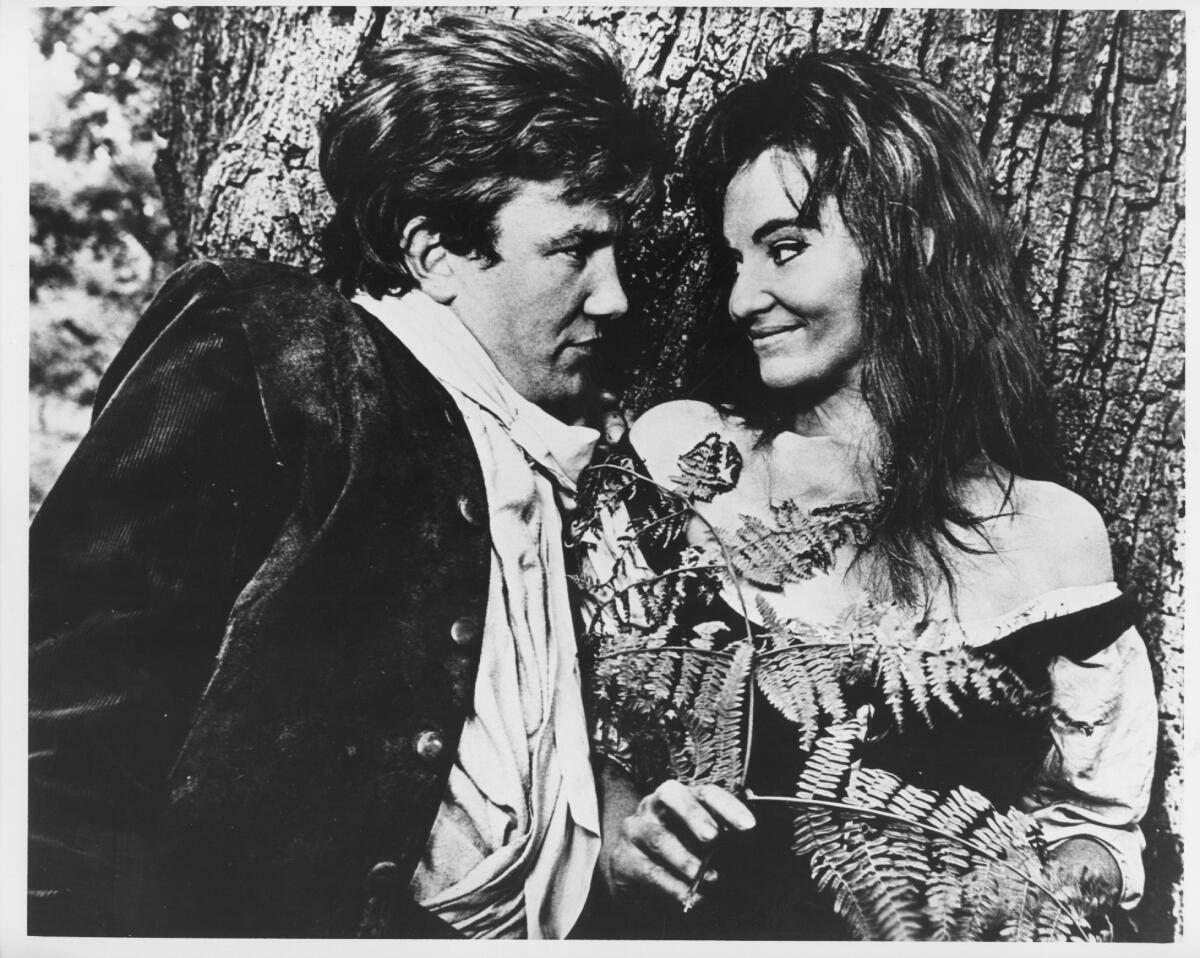From the Archives: A merrie romp with one of the Jones boys

- Share via
Two aspects of Merrie England are on their way to movie theaters. Both are in exceptional color. One, “Tom Jones,” takes place in the 18th century; the other, “The Sword in the Stone,” in the 6th century. The British-made “Tom Jones,” for adults, will arrive next Thursday at the Beverly Theater. Walt Disney’s animated cartoon feature, a promised Yuletide gift, is for children — but parents won’t fret.
Astonishingly faithful to Henry Fielding’s classic, “Tom Jones” was adapted by a not-quite-so-angry John Osborne and directed by that hitherto modern realist Tony Richardson. Even so, it is bawdy, bellicose, sprintingly acted and photographically arresting. An ever-increasing band of devotees is, equally loudly, already proclaiming it a masterpiece. Unquestionably, it is 1963’s dark horse.
Fine period piece
I find it, also, a paradox. For an unremitting saga of animal appetites in a decadent society, as gamy as it is lusty, it alternately stimulated and wearied me for its more than two hours of gambols on and off the green. It is so determinedly, so precociously artistic that it nagged at me incessantly to find fault with it. And I did — mainly because of its two styles, which seemed to me incompatible.
On the one hand, “Tom Jones” re-creates its period magnificently. It is all the best and the worst of British humor, from Chaucer to Coward — with excursions that suggest Shakespeare, Chaplin, Hogarth, “Oliver Twist,” “The Threepenny Opera,” “Jules et Jim” and what-have-you. On the other hand, Richardson and his associates have superimposed on it just about every trick of the trade since the flickers began — silent technique, complete with subtitles; images speeded up by undercranking; stop motion; spoken asides to the audiences; irises and wipes; and everything from hand-held cameras to helicopters.
Amorous adventures
Now, some of these devices — the hand-held photography of the stag hunt, for example, adds an extra dimension of jiggling excitement — are legitimate enough. But too often I had the feeling their users were throwing them in either out of condescension toward the whole milieu or because they didn’t really believe it would hold up without them. What they did to me, at any rate, was to keep yanking me back to the reality of my theater seat and to keep me repeatedly aware that I was watching only the mechanics of a movie.
Tom Jones is born out of wedlock and stays out of it through a succession of amorous adventures with one beauteous damsel after another until the final reel, in which he is pledged in marriage to his one, perhaps, true love. She is Sophie, childhood sweetheart and daughter of terrible-tempered Squire Western from a neighboring manor. In between, a young Quixote flailing at windmills, he has been to London Town from Somerset, encountering all sorts of brawling and bawling inhabitants along the way.
Bull in a china shop
Among the females with whom “our incorrigible hero” dallies, violently or tenderly, are Molly, local trollop; Mrs. Waters, whom he has rescued, beaten and half-naked along the road; and the elegant and sensual Lady Bellaston. While his affair with nobility is often hilarious, it has nothing on the byplay that goes on between him and Mrs. Waters in the scene of gourmandizing that will go down in history. Eyeing one another steadily, saying nary a word, they stuff their mouths with dripping goodies in a rite that becomes the personification, even beatification, of sex a la carte.
“Tom Jones” wallows in the lowest instincts of its people — instincts that are hysterically emotional and unfailingly gross and brutalizing when they are not simply carnal. And Tom — as portrayed with an irresistible joy of living by Albert Finney — makes him as much rogue as saint, as much devil as blond angel. It is a narrow tightrope he walks indeed.
As great a performance in his way is given by Hugh Griffith as a roaring, roistering Squire Western — a bull in a china shop if there had been a china shop.
The variously lovely (by courtesy) ladies include Joan Greenwood of the husky purr as Bellaston, Joyce Redman as the mysterious Mrs. Waters and Diane Cilento as the wild Molly.
Likewise contributing are David Warner (Blifil), Dame Edith Evans (Miss Western), George A. Cooper (Fitzpatrick), George Devine (Squire Allworthy), David Tomlinson (Lord Fellamar), Rosalind Knight (Mrs. Fitzpatrick), James Cairncross (Parson Supple), Peter Bull (Thwackum), Wilfrid Lawson (Black George) and still others.
The exquisite color photography was painted (sometimes too darkly) by Walter Lassally. Production designer was Ralph Brinton. John Addison composed a jingly music score, the harpsichord predominating. “Tom Jones” is a Lopert release.
Disney’s ‘Olde England’
Considering that “The Sword in the Stone” takes place amid the pomp and panoply of medieval England, it is more “intimate” than usual with a somewhere smaller cast of characters — animals as well as human. Otherwise the youngsters should find it par for the Disney cartoon course. It may not be exactly what T.H. White had in mind when he wrote this third of his sophisticated trilogy about King Arthur, but it’s a good deal livelier than the stage “Camelot,” derived from another third.
Not that its score is comparable to Lerner and Loewe’s. Richard M. Sherman and Robert B. Sherman have supplied it with such typical and self-explanatory song titles as “Higitus Figitus,” “A Most Befuddling Thing,” “That’s What Makes the World Go ’Round,” “Blue Oak Tree” and the like. The 10 voices utilized include those of Sebastian Cabot, Martha Wentworth, Ginny Tyler (a darling little girl squirrel), Karl Swenson, Alan Napier, et al.
Among the enduring principals are Merlin the Magician (a jolly old Merlin here); Archimedes, his “highly educated owl”; the aforementioned girl squirrel and granny squirrel; and, of course, Wart, the 12-year-old lad who is destined to be crowned king of England. Less lovable but not too fearfully menacing — Disney has soft-pedaled the cruelty in this one — are Kay, Wart’s dim-witted foster brother; mad Madam Mim, a witch; and an incidental wolf.
Merlin, who can see into the future, undertakes the task of “educating” Wart, though he isn’t quite sure what for. In order to accomplish this (his reasons, too, are somewhat fuzzy) he changes Wart and himself variously into fish, squirrels and sparrows. The climactic sequences really occur in a whirlwind “wizard duel” between Merlin and the mad madam as they transform themselves into different kinds of beasts, and what follows in London — the tournament and Wart’s pulling of the sword from the stone — seems a rather tame let-down.
Artisans at work on the 80-minute feature were led by Bill Peet, who adapted the T.H. White story, and Wolfgang Reitherman, the director.
More to Read
Only good movies
Get the Indie Focus newsletter, Mark Olsen's weekly guide to the world of cinema.
You may occasionally receive promotional content from the Los Angeles Times.










